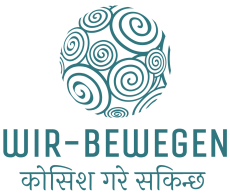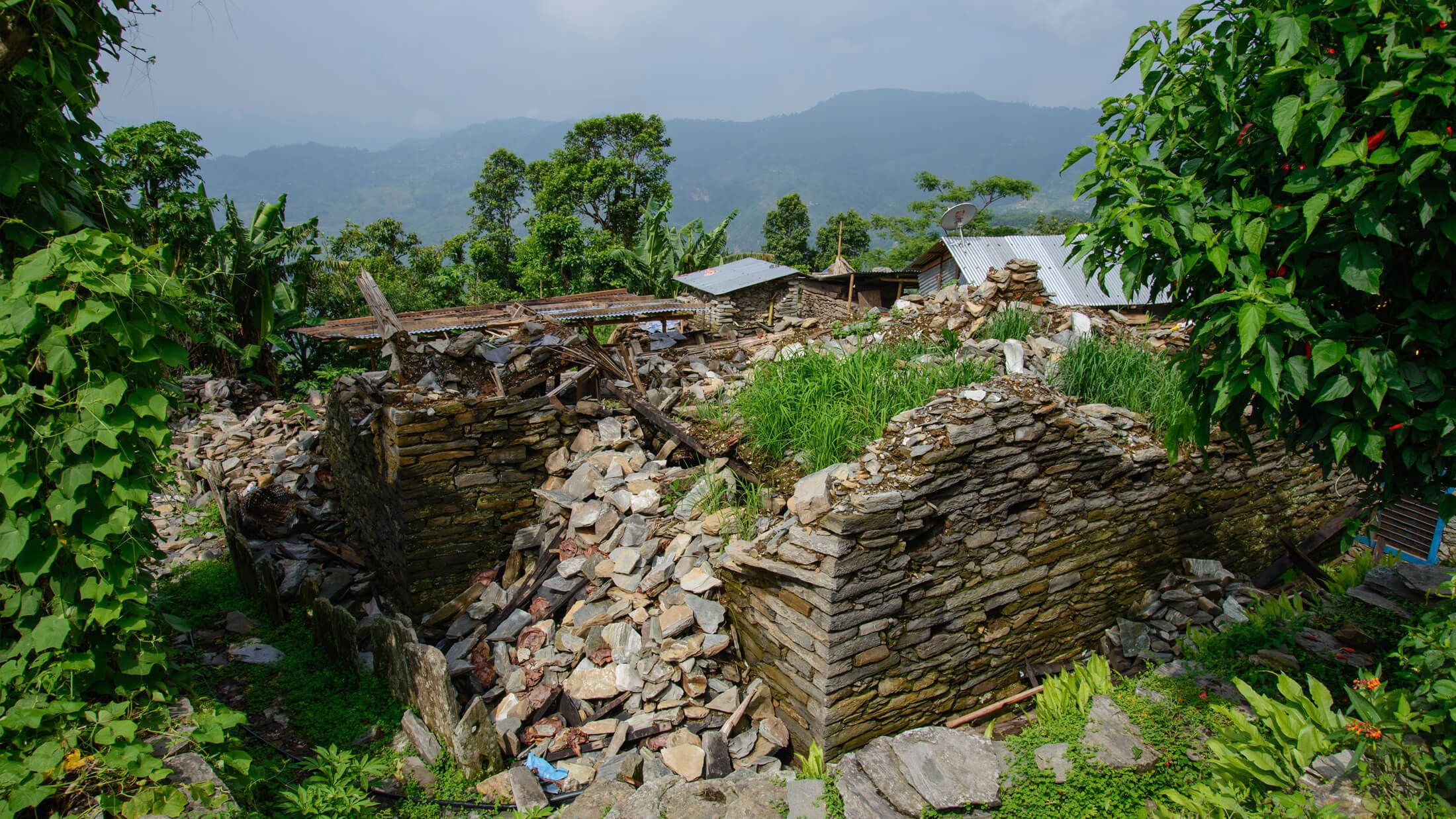July 2015 | first journey
Despite good preparations, we embarked on this journey with mixed feelings, because we didn't know what to expect.
- What will the conditions be like on site?
- Will we be able to enter the country easily with the goods we brought with us (medicines, seeds, Clothes , lamps and mosquito nets)?
- Will the currency exchange be possible without major problems?
- How do we get the materials we've brought with us, and especially the materials we still need to get, into the village?
Many questions remain, but everything should work out wonderfully.
It's starting!
At check-in at Zurich Airport, we were able to check in our six pieces of luggage without any problems. The permitted 60kg was exactly reached during the weighing process, in our favor; even our hand luggage, each weighing over 7kg, was accepted. The first hurdle was cleared, and our nervousness subsided somewhat. Fourteen hours later, we set foot on Nepalese soil. All our luggage was on the conveyor belt, and we left the airport with a sense of relief. Our friend Narayan was already waving to us and hung flower garlands around our necks as a welcome gift. During the taxi ride to the hotel, the first signs of collapsed buildings came into view, but it was also clear that everyday life had already returned.
The media's reporting of a destroyed Kathmandu is not entirely accurate, as this deters tourists, even though there is hardly any difference in quality of life compared to before.
The first few days in Kathmandu are dedicated to organizing. Our friend Narayan is on the phone a lot, and we sit beside him, drinking tea and making decisions.
We need to exchange the Swiss francs (14,000 CHF) for Nepalese rupees. A currency exchange offers us a good exchange rate. After only a 10-minute wait, we receive an enormous stack of banknotes, enough to fill an entire daypack.
Step two is to increase the supplies we've brought with us so that all 32 families in Bhumesthan receive a lamp and a mosquito net—it should be fair, after all. We buy 22 headlamps with extra batteries and order 11 Nepalese mosquito nets from the local market.
We want to bring food for a section of Phulkarkas inhabited by an ethnic minority—the Gurungs. Narayan orders the food by phone and has it delivered directly to the village.
Adventurous journey
Our journey to the village begins with a taxi ride to Dhading Besi, the district capital of the region. After a good three hours, we reach the small town, situated at approximately 700 meters above sea level. We had planned to travel to the village by jeep the next day, but the driver cancels at short notice without explanation. So we have to find another option. Fortunately, the food we ordered is already in Dhading Besi and will be delivered to the village the following day by a 4WD truck. The driver agrees to take us along as well – for an extra fee. We were lucky, because a 35km hike in about 32°C and 90% humidity would have been very strenuous. We are allowed to ride in the truck's cab; other passengers have to sit in the back.
The journey starts on a partially paved road – but the road conditions deteriorate steadily with each passing hour. The truck has to navigate ditches that are knee-deep and filled with water. But for the experienced driver, this poses no obstacle. We now understand why the Jeep driver canceled on us – getting through here with small wheels is impossible. The truck struggles through the mud up the mountain – impassable sections are simply made passable somehow. After a detour – another truck is blocking the road – and a repair to our truck – a broken spring – we reach Bhumesthan after about 12 hours of bumpy driving.
Luckily, it only started raining in the late afternoon – otherwise, it would have been very difficult to reach our destination.
A warm welcome awaits us, and we settle into our camp, which has been specially built for us onto one of the temporary corrugated iron huts. To be honest, we almost would have preferred to sleep in a tent on our comfortable mats rather than on this hard plank ;-)
The next morning, we begin our tasks and first distribute the food we brought to the Gunrung families . Everyone has gathered at the Bhumesthan village meeting place and is called up individually from a list. The food package contains a 25kg sack of rice, 2kg of lentils, 1L of cooking oil, and 1kg of salt. Mostly women gratefully accept the food and carry it up the mountain to their homes for about an hour. An old woman thanks us profusely, embraces us, and gives us a wet kiss on the cheek. Unfortunately, we don't understand her words—but you can feel her gratitude nonetheless!
But life goes on. No complaining; instead, they look ahead and make the best of it.
The temporary corrugated iron huts are surprisingly sturdy – they withstand wind and weather – at least for one monsoon season. The corrugated iron sheets were provided by various organizations. Additionally, people reused wooden doors and interior walls salvaged from the rubble to give their new shelters a basic structure.
Next, we went to the Phulkharka headquarters. The tragedy claimed 28 lives in Phulkharka. We are providing financial support to the victims' families . All families are being summoned and called by name from a list, ensuring no one is forgotten.
Phulkharka's school is also in a terrible state. Only three buildings remain standing – just the main building, constructed by Italians a few years ago, is still in very good condition. Tents and corrugated iron shacks have been set up in the large square in front of the school, serving as makeshift classrooms. The school educates approximately 780 students, many of whom walk for up to three hours each day. The school committee is expecting us, and we are presenting them with 300,000 rupees in support. We're giving the committee free rein to decide how best to use the money. They express their sincere gratitude for this generous contribution, even though it's obviously just a drop in the ocean. We're told that we're the largest donors so far, which means our contribution will be used for emergency aid. More furniture and supplies need to be purchased to ensure a reasonably regular school day.
Back to Bhumesthan we go. All the children gather around the Clothes . Most of the children are bigger than we were told – we had Clothes for younger children – but we still manage to find at least one item for each child. They wait patiently until we hold up a garment and point to a child who might be the right size. After successfully trying it on, their faces beam. Only with a bag full of socks does the process become a little less orderly. Who would have thought socks would be so popular? :-) The older onlookers and we ourselves laugh at this frenzy and the joy.
We spend our evenings relaxing with Narayan's family and neighbors. They always cook for us, offer us tea frequently, and try to communicate with gestures. We also meet up again with our friends from the 2010 trek – it's wonderful to see so many familiar faces. We
shower outdoors. A spring right in the village has been developed into a large well. A blessing in this heat!
Now it's the turn of the residents of Bhumesthan . The whole village gathers at the village meeting place, "Lazy Stone" – there's no such thing as a community center. Bhumesthan is situated on a steep slope and consists of about five groups of houses, each of which has appointed a chairman for the "construction committee." In the presence of the entire village, we present the committee with 600,000 rupees for the reconstruction. The handover is accompanied by enthusiastic applause.
We also give them a box of medicine and bandages. Narayan's brother Arjun's house serves as a first-aid post. This contact point was used several times that same day.
We presented a sack full of seeds to the "most diligent farmer." He will grow seedlings and then distribute them. Narayan emphasized to the villagers that these were not Monsanto seeds, and some nodded in appreciation. As with every handover, the villagers applauded.
All 32 families in Bhumesthan also received a lamp and a mosquito net. A few families had access to some electricity in the evening from a small hydroelectric plant, allowing them to recharge their lamps with batteries. Everyone was grateful for our gifts. Older people, in particular, expressed their heartfelt thanks, some barely able to believe it. They said it was incredible; we could have traveled anywhere in the world, but we came here to help them.
We realize that with this small help we have brought people a lot of hope and confidence that things will move forward again.
In the evening, the "construction committee" met to develop a reconstruction strategy. After their deliberations, they presented their findings to us. They intend to abandon their traditional building methods and instead construct earthquake-resistant houses—or at least, that's the direction they want to take. We very much welcome this decision. With our support, it will certainly be possible to lay a solid foundation for at least the 32 houses. To achieve this, cement, sand, and reinforcing steel need to be purchased. This will provide each house with a solid foundation and four or six pillars for each story. The walls between the pillars will then be rebuilt in the existing style using local stone. Bricks are unavailable, as almost all brick-making facilities in Nepal were destroyed in the earthquake. The roofs can be constructed of wood and covered with corrugated iron.The work is carried out by the villagers themselves - except at the beginning when specialists must be hired to impart the know-how.
The estimated cost is around 230,000 rupees. We are optimistic and promise to do our best to raise further donations.
It would of course be nice to be able to contribute more money so that the stones in the walls could also be fixed with cement.
Our project is therefore concluded for the time being. Construction will begin in October 2015, as soon as the monsoon season is over, because the heavy loads can only be transported to the site via a dry road. Our goal is for all 32 houses to have foundations before the next monsoon in June 2016. An ambitious goal – the residents will also have to cultivate their fields alongside the construction work.to be continued…
We then spent a few quiet days in Kathmandu, allowing us to let the many experiences sink in.It was once again a very nice time in Nepal, despite the many sad stories we heard and saw.
The first part of our project has been successfully completed.
After four days in Bhumesthan and with a good feeling about it, we're leaving again. We were touched by how many villagers came to say goodbye. They're very happy that we plan to return in the fall.
All our initial concerns have been swept away, as everything went extremely smoothly. Narayan provided us with tremendous support. Without his help and that of his brother, this would never have been possible. We believe we were able to use the donated funds very effectively and efficiently.



























